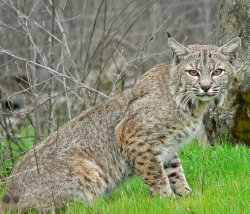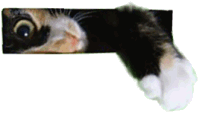Crowdsourcing information on rare cats - how reliable are the photographs?
How many wild cats live in a particular habitat? Are they thriving or endangered? Wildlife researchers will sometimes frankly admit that they can only guess the answers. Wild cats are by nature are shy and reclusive, and generations of being hunted by humans has not helped. Also most cats are nocturnal or crepuscular (active at dawn and dusk) making these well-camouflaged felines even harder to spot.
 |
The advance of technology is helping. These days it is getting easier to 'trap' wild cats - or at least their images - on infrared cameras which work in the dark. Unlike trapping - and traumatizing - the actual cat, these pictures are so non-invasive that the cat does not even know it has been photographed.
A new research tool has become available thanks to the internet. Almost everyone goes equipped with a camera these days since they are incorporated into their phones. And most people who see a wild cat will photograph it. As a result researchers have started soliciting such images, or searching for them online in social media. But since those taking the pictures often leave out relevant detail - time of day, habitat, location and so on - the question is whether the information gathered in that way is accurate enough for statistical purposes, especially as the picture quality is often not the best.
This question is exactly what Professor Karen Hodges and her student T.J. Gooliaff from the University of British Columbia have been trying to answer in their recent studies. One objective was to determine how accurately one can distinguish between two closely related wild cats, using pictures from camera trapping and publicly solicited images. The two wild cats selected were the Canada Lynx and the Bobcat.
The only place in the world where the Canada Lynx and Bobcat coexist is along the Canada - U.S. border. As you might have guessed from the name, Canada Lynxes live mostly in Canada but there are also a handful of them in northern U.S. states such as Maine, Minnesota, Montana, Wyoming and Washington. The number of Canada Lynx south of the Canadian border is thought to be low but no-one really knows for sure. The Bobcat is the dominant species throughout North America, partly because it it happy with a more varied habitat - from marshes and swampy areas in the southern USA, to desert and scrub in the west, mountains everywhere, and Canadian forest and tundra.
Yet when you see and photograph either a Canada Lynx or a Bobcat, how do you know which is which? Both cats are technically Lynxes but they are classified under different species. The Bobcat family is Lynx rufus whereas the Canadian Lynx is (unsurprisingly) Lynx canadesis. Which does not help much when you are looking at one, so some visual clues might also be helpful.
Bobcats are often called 'overgrown domestic cats'. They have a gray to brown coat, a whiskered face, and black-tufted ears. At a glance, a young Bobcat might be mistaken for a large tabby. A closer look at a Bobcat will reveal distinctive black bars on the forelegs and the black-tipped, stubby (or "bobbed") tail, from which this species derives its name.
Compare that with a Canada Lynx. The Canada Lynx has a more stylish dense, silvery-brown coat which becomes more reddish in summer. Like the Bobtail it has a short tail with a black tip, a characteristic furry ruff which resembles a double-pointed beard, and long, furry tufts on its ears. So there’s not too much here that separates the two species visually.
There are some differences. The average Canada Lynx is slightly larger than the average bobcat and has longer legs. Which is really only helpful if you know you are looking at an 'average' specimen. However, you have more luck looking at the paws. Very large, broad, paws with fur on the top and on the pads tell you that you are looking at a Canada Lynx.
Once they had sorted out how to tell the two species apart, Gooliaff and Hodges asked the public for pictures and received 4,399 images from the people of British Columbia in Canada. They then tried to find the provincial distribution of each species. They used pictures, trapping records and other data sources to develop current range maps.
The next challenge was to see what even a high-quality image had captured. The researchers selected 300 of the best images and asked asked 27 individual bobcat and lynx authorities to classify the species in each picture. It was a struggle.Over seventy percent of images were classed as 'unknown'. In 39% of the pictures some experts reckoned the picture was of a bobcat while others classified it as a lynx. Furthermore, experts were inconsistent even with themselves. When they were asked to reclassify the same images months later, some changed their opinion of the species in the picture.
This study was recently published in the Journal of Wildlife Management (see ref below) and the authors concluded that classification of images by a single expert is unreliable for similar-looking feline species. (Although in this study most of the images did obtain a clear majority classification from the experts.) Nevertheless, the fact that the experts themselves were often uncertain means that classification by photographs alone comes with a large margin for error. The authors concluded that if conclusive evidence is required to show the presence of a species when a highly similar species shares that habitat, physical or genetic evidence is still required.References:
TJ Gooliaff, Karen E. Hodges. Measuring agreement among experts in classifying camera images of similar species. Ecology and Evolution (2018) 8(22), Pages 11009-11021. https://onlinelibrary.wiley.com/doi/full/10.1002/ece3.4567
And just in case you are wondering. The picture above shows a Bobcat (Lynx rufus), taken at Sunol Park near Livermore CA, USA.

